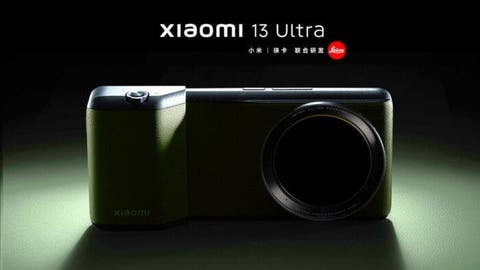A long time ago, smartphone makers agreed that the camera should be one of the key features of a smartphone. But it was only a few years ago that the major Android handset manufacturers started to produce smartphones that could compete with SLR cameras. Today, as planned, a leading Chinese company has unveiled the Xiaomi 13 Ultra, a real camera phone.
The camera
The Xiaomi 13 Ultra’s camera is the first thing we should talk about, as it is what sets it apart from other smartphones. It has four sensors. It has a 12mm super wide angle lens, a 23mm primary lens, a 75mm telephoto lens, and a 120mm super-telephoto lens, and it supports a digital zoom of up to 120 times.
The Xiaomi 13 Ultra also features a new generation Summicron lens. Xiaomi and Leica collaborated on the latter. According to Leica brand ambassador and renowned street photographer Matt Stuart, the 13 Ultra is a professional photography tool, not a camera phone.
The Sony IMX989 CMOS sensor is used in the lens specs of the primary camera. The latter allows for a variable aperture.
The Sony IMX858 is used in the other three lenses. These three sensors are now the most tech-advanced Sony mobile sensors and the only ones with features that can challenge the IMX989 sensor. The ISZ extended focal length function provides six focal lengths, covering a zoom range of 12mm to 240mm.
The light capture of these three sensors has increased by between 14% and 43% compared to the previous generation, thanks to a larger aperture. As a result, the overall light-sensing capability has improved.
To demonstrate the benefits of this phone, Xiaomi compared it to the iPhone 14 Pro Max. The samples show that the iPhone 14 Pro Max has an oversharpening problem.
Appearance
The back of the Mi 13 Ultra is designed to look like a camera, much like the legendary Leica M series.
In terms of materials, it uses a unique stitching pattern in smooth leather and an exaggerated pattern of curves. This design has the same “origin” as the camera.
The phone also features second-generation Nano Skin technology, which is resistant to dirt and peeling. The integrated metal frame body increases the overall bending strength by 4.4 times and provides IP68 dust and water resistance.
There are three colorways. In addition to olive green and black, a white version has been added.
Xiaomi 13 Ultra Screen
A curved 2K OLED screen is used by this phone. Xiaomi and a domestic manufacturer worked together to create it. Not only does it use a new-gen of C7 phosphor material, but it also has a peak brightness of 2600 nits and optimizes color shift and power consumption at wide angles. It also beats the industry standard in terms of optimization, even outperforming the Samsung E6. In addition to brightness, the Mi 13 Ulta’s screen features LTPO dynamic refresh rate and 1-120Hz adaptive.
It also has a professional primary color display mode as standard, which gives more accurate color reproduction, a sharper image, and a better viewing experience.
Xiaomi uses the latest CIE2015 color space for calibration. It can achieve high color consistency with Apple’s Pro Display XDR display.
In terms of eye safety, the Xiaomi 13 Ultra also supports DC dimming and 1920Hz PWM dimming.
Performance
The Xiaomi 13 Ultra sports Qualcomm’s second-generation Snapdragon 8 mobile platform. There is also a 5000mAh battery supporting 90W of wired and 50W of wireless charging.
We need to mention that the Mi 13 Ultra comes with Suge P2/G1 chips. They improve battery life and overall performance. The device is compatible with the emergency mode for extended battery life. When only 1% is left, it can survive for 60 minutes.
Xiaomi has also introduced a new heat dissipation tech called an annular cooling pump for heat dissipation. In comparison to common VC, it has a 300% improvement in heat dissipation. It can also achieve 60 frames of 4K continuous shooting without losing any frames.
With the rapid progress of mobile phone imaging, the power consumption of the imaging function is often comparable to that of large-scale 3D games that require the highest image quality. So the annular cooling pump technology has corresponding features as well.
The Xiaomi 13 Ultra outperforms the iPhone 14 Pro Max for gaming, photography, and charging.
At the same time, Xiaomi has abandoned USB 2.0, which was the most annoying issue for consumers on the previous version of the Xiaomi 12S Ultra.
Xiaomi 13 Ultra Price
Xiaomi has removed the 8GB version, but the starting price of 5999 yuan ($872) has remained the same.
In contrast, the 8GB+256GB Mi 12 Ultra costs 5999 yuan ($872), the 12GB+256GB Mi 12 Ultra costs 6499 yuan ($945), and the 12GB+512GB Mi 12 Ultra costs 6999 yuan ($1018).
As for Xiaomi 13 Ultra prices, the 12+256GB model costs 5999 yuan ($872), the 16+512GB model costs 6499 yuan ($945), and the 16+1TB model costs 7299 yuan ($1061).
Xiaomi has also released a pro photography package for 799 yuan ($116). It includes filter adapter rings, wireless camera handles and other accessories.
